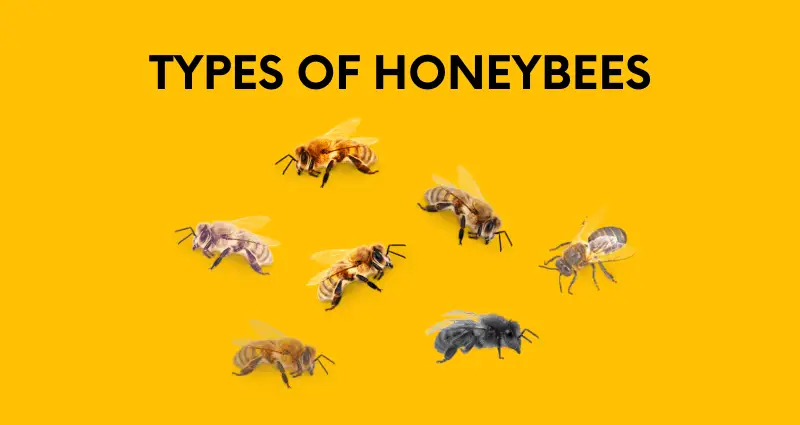There are over 1,000 individual honey bee species worldwide, including Italian, Eastern, Buckfast, German, and Africanized bees.
Not to mention over 20,000 individual bee species worldwide!
This post dives into the different types of bees and their role in the world’s pollination and honey economy.
The different honey bees include:
- The Buckfast honey bee
- The Italian honey bee
- The German bees
- The Caucasian honey bee
- The Africanised bees
- The Carniolan honey bee
- The Minnesota hygienic bees
- The Hybrid stock
- The Eastern honey bee
What Sets Honey Bee Types Apart?
The Buckfast Bee
The strongest of all European honeybees, Buckfast bees were first bred in England by Brother Adam and Brother Joseph Williams in Glastonbury, Tor.
They’re often used as a backup or insurance population to improve other strains with high susceptibility to threats such as varroa mites.
The Italian Honey Bee
The Italian honey bee species is the most common type today. The Italian honey bee is also known as Apis mellifera ligustica. They are found all over Europe, Africa, and Asia.
These bees developed from Italian stock introduced into southern France in 1956. They are gentler than many other breeds but produce less honey because their colonies tend to be smaller due to swarming tendencies during warmer seasons. However, they are known for producing high-quality beeswax.
Italian honey bees are dark brown, with a few amber-colored hair bands. They have yellowish to white abdomens, and queens can sometimes be seen with a dark stripe on their stomachs.
They are distinguished from other honey bees due to their mild temperament. They are, therefore, easy to work with.
The German Bees
German bees are a variety of honey bees common in the United States. They were brought to the U.S. by European settlers and have been around for over 200 years.
These are gentle giants equipped with long tongues that reach deep into blossoms for nectar and pollen. Their long tongues allow them to live in cold climates better than other honeybees.
Commercial beekeepers also use them extensively because they produce more honey than other breeds.
German bees are hardy and tolerant of colder temperatures, perfect for northern climates. They produce light honey with a mild flavor and have less brood than other breeds.
The Caucasian Honey Bee
Caucasian honey bees are found in Eastern Europe, Anatolia, the Caucasus Mountains, Central Asia, Afghanistan, Pakistan, China, and the Indian subcontinent.
They are an aggressive species with a strong tendency to use their stinger on humans. Also, they can be identified through their dark/gray hairy bodies and long tongues.
Also known as Apis Mellifera Caucasica, the Caucasian honey bee has a long tongue to make it easy to forage nectar from flowers that other bees can’t access. They take longer to build propolis/bee glue, making them less active within the beehive.
Resultantly, Caucasian honey bees are not good producers of honey and honeycombs compared to their counterparts. This explains why they are not the favorite for veteran and beginner beekeepers.
The Africanized Bees
Also known as the killer bee, the Africanized honey bee is swift to swarm and attack when disturbed. They are a hybrid of European and African honey bees.
They were first discovered in Brazil in 1957 and have since spread to other parts of North America, South America, Africa, and Australia.
Africanized bees are more defensive and more likely to attack humans. It has been found that these bees will kill at least ten times more people than other types of honey bees.
The Carniolan Honey Bee
Carniolan honey bees are also known as Apis Mellifera Carnica. Originally from Slovenia, they have spread across central Europe, especially in Croatia and Bosnia-Herzegovina.
Carniolan honey bees have a reputation for being more productive than other types of bees. Also, they have a highly docile nature. This explains why these honey bees are so popular with commercial beekeepers.
The Carniolan honey bee hosts huge hair, giving it a dark color to distinguish them from other honey bees. However, this bee stock is known to swarm during spring, which leads to poor honey yields as honey bee colonies split through the season.
The Minnesota Hygienic Bees
Minnesota Hygienic bees are bred for their hygienic qualities. They don’t produce as much propolis as other bees because they groom themselves and each other more often than races of honey bees.
They also have a shorter life cycle, so they don’t build up as much honey as the other breeds because the queen only lays eggs for about five days.
However, because Minnesota Hygienic bees don’t produce as much propolis and are bred to keep themselves and each other clean, they are popular in commercial beekeeping operations where cross-contamination is a risk.
The Hybrid Stock of Honey Bees
Bees have mixtures of traits that make a “hybrid stock.” When can they sting, when can they bite, and when can they fly? What is their life cycle, and what is their range?
Hybrid breeds of honeybees are increasingly being seen in hives around the world. In some cases, they’re the only bees to survive from the original colony in a hive. They have been bred to be a gentle and welcome alternative to standard-issue bees.
The hybrid stock of bees results from beekeepers looking at ways to improve the genetic quality of honey bees. These subspecies bees are known for higher quality honey production and more resilience. Meanwhile, genetics is leading the quest for more robust and sustainable species of bees.
The Eastern Honey Bee
Also known as Apis Dorsata Laboriosa, this is the most widespread honey bee species. It thrives well in Asia, Africa, Europe, and Australia.
The color of this type of honey bee ranges from brown to black, with some variations in between. They are often seen with pale hairs on their head and thorax.
They are an aggressive species that chase after anything that disturbs them at their hive. This also includes people who want to collect their honey!
FUN FACT: Albino bees are a catch-all term for bees that may look white/pale in color. Click here to read more about Albino Bees, or click here to read more about varying bee colors.

